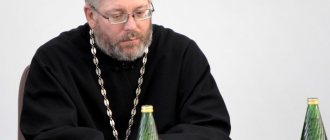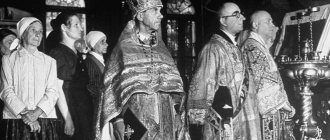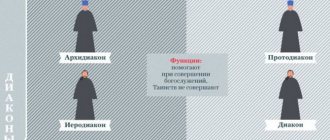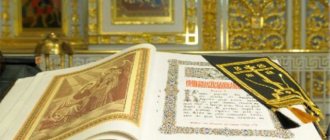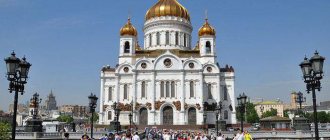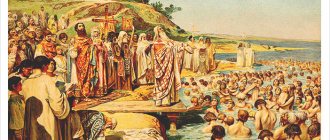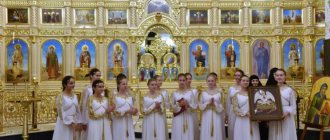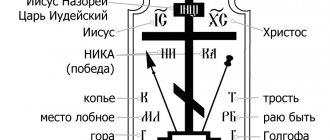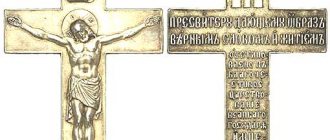Missionary activities of the Russian Orthodox Church
There were internal
and
external missions.
The first carried out its work among Old Believers, sectarians, Catholics, Protestants and other Christian denominations in Russia, the second - among the non-Christian population both in Russia and abroad.
In the first half of the 19th century. There were Perm, Samara, Orenburg, Kazan, Altai, Irkutsk, Transbaikal, Obdorsk, Surgut, Yenisei, Yakut and Kamchatka missions, whose task was to Christianize the peoples of the Volga region, the Urals, Siberia and the Far East. The Synod decided to send priests who knew local languages as missionaries among non-Russian peoples. In 15 theological seminaries of Kazan, Irkutsk and other dioceses, training of seminarians in “foreign languages” was introduced. The missionaries were charged with the duty of healing the local population, even. arrangement of their “economic life” with advice, examples, and sometimes material support.
Among the missionaries there were enthusiasts of their work, who performed their assigned duties not out of fear, but out of conscience, and thereby brought a lot of benefit to the local population. For example, in 1824 the “Samoyed” mission
(among the Eskimos and Nenets in the polar part of the Arkhangelsk province) was headed by Archimandrite
Veniamin Smirnov of the Siysk Monastery.
He studied the Eskimo language, compiled its grammar, translated the Gospel, the Acts and Epistles of the Apostles, and the Orthodox Catechism into it. He conducted services and sermons in the local language. V. Smirnov was also involved in ethnographic research in this region.
An example of asceticism and dedication was the missionary activity of Archimandrite of the Kursk Glinsk Hermitage Makariy Glukharev
in the 30s of the XIX century. in the Altai region. With his strict life and tireless work, he gained universal love among the local population. He was in no hurry to baptize local residents: first he held conversations with them, helped them with their needs, set up their household, and treated illnesses. To educate children, M. Glukharev founded three schools, and an almshouse for the sick and infirm. During the famine of 1839 in that region, he obtained help from the treasury for the residents. Macarius built a church and two houses for members of the mission. He translated the Gospel, selected passages from the Old and New Testaments, the Catechism, teachings, and necessary prayers into the Khakass language.
In 1794 in the North American possessions of Russia
The Kodiak mission was founded by the monks of the Valaam Monastery.
Ivan E-seevich Popov-Veniaminov,
sent from the Irkutsk diocese who was later nicknamed “the apostle of Russian America.”
He arrived in the Aleutians with his family in 1824 and stayed there as a priest and missionary until 1834, then he was appointed archpriest in the “capital” of Russian America - Novo-Arkhangelsk on the island. Sith. Veniaminov was distinguished by his exceptional devotion to his missionary work. Having studied the Aleut and Kolosh languages, he spread Christianity throughout Russian America. In 1840, on his initiative, the Kamchatka diocese was founded, at the head of which he was placed. In 1840, after the death of his wife, he became a monk, taking the name Innocent,
and was soon elevated to the rank of Bishop of Kamchatka, Aleutian and Kuril. During the 27 years of his leadership of this remote diocese, he traveled throughout Eastern Siberia and did a lot to spread Christianity in this region. He created the alphabet and grammar of the Aleut and Kolosh languages, and translated the main liturgical books into these languages. Innokenty Veniaminov has received recognition in scientific circles as a deep researcher of the ethnography and geography of Russian America. Subsequently (in 1868) he was made metropolitan of the Moscow diocese.
mission in Japan had significant success
thanks to the tireless work of its founder and leader, Fr.
Nicholas
(in the world
of Ivan Dmitrievich Kasatkin).
Upon graduating from the St. Petersburg Theological Academy in 1860, he was appointed rector of the church at the Russian consulate in Hakodate. Then he perfectly studied the Japanese language, acquired a thorough knowledge of the literature and history of Japan, Confucianism, Shintoism and Buddhism. In 1870, he obtained from the Synod the establishment of the Japanese Orthodox Missionary Society and became its head. In 1871, he established an Orthodox diocese in Japan, which Nicholas, already in the rank of metropolitan, headed until his death in 1912. By the beginning of the 20th century. through his efforts were turned into
Orthodoxy 34 thousand Japanese, an Orthodox cathedral was erected in Tokyo, 8 large temples, 275 churches and 175 houses of worship were built.
Orthodox mission in China,
founded in 1815, it also served as the diplomatic and trade mission of Russia at the court of the Chinese emperors.
The mission staff studied the history, culture and economy of China. An outstanding missionary and sinologist of the Russian Orthodox mission in China in the 19th century. (since 1807 its head) was Nikita Yakovlevich Bichurin
(in monasticism
Iakinthos).
Having mastered the Chinese language, he studied the history and culture of China, compiled an extensive library of rare Chinese books, including ancient ones, which he then donated to the Kazan Theological Academy. Bichurin became widely known in scientific circles as the author of many studies and translations on the history, philology and philosophy of China, Tibet and Mongolia. By the beginning of the 20th century. The Orthodox mission in China had 17 churches, three monasteries, a theological seminary, 17 lower male and female theological schools, libraries, a printing house, a lithography, an icon-painting workshop, several industrial enterprises, apiaries and farms.
In 1897, the Russian Orthodox mission was founded in Korea, but its successes were very modest: by the beginning of the 20th century. it converted no more than 500 local residents to Orthodoxy, and in connection with the outbreak of the Russian-Japanese War of 1904-1905. the mission was forced to leave the country and temporarily cease its activities.
In 1847, a Russian spiritual mission was established in Palestine
(located in Jerusalem).
She was engaged not so much in missionary as in charitable activities, but most of all in serving Russian pilgrims, who visited Palestine annually in the amount of up to 10 thousand people. In 1882, the head of the Russian mission in Palestine, Archimandrite Anthony Kapustin ,
The acquired possessions were called Russian Palestine. The Palestinian society built Orthodox churches, monasteries, schools, hospitals, almshouses, and published scientific works. The scientific yearbook “Palestinian Collection” became widely known.
In the second half of the 19th century. The missionary activities of the Russian Orthodox Church received clearer organization and coordination of actions. In 1853, the Synod issued a decree on the opening of missionary departments for the training of special personnel in theological academies and in some seminaries, especially for work among “schismatics.” For training in these departments, it was prescribed to select the most capable seminarians, freeing them from studying ancient languages - Latin, ancient Greek and Hebrew. Instead of these items, the following were introduced:
the history of the Russian schism, modern statistics of schism in all its forms, as well as a course of practical instructions for missionaries.
In 1865, the “Missionary Society to Promote the Spread of Christianity among Pagans” was founded in St. Petersburg. In 1868, it was replaced by the “Orthodox Missionary Society” in Moscow, which was headed by Moscow Metropolitan Innokenty, who had extensive experience of many years of missionary service in Russian America. To assist the Missionary Society locally, its “diocesan committees” were established, headed by diocesan bishops. By 1896, the Orthodox Missionary Society had 14 thousand members. In addition to assisting Orthodox missions in converting “non-Christians living within the Russian Empire” to Orthodoxy, the task was also to fight against the various sectarian denominations that had spread at that time. Since 1887, missionary congresses began to be held: until 1912, five such congresses were held. Special missionary magazines were published - “Missionary Review” and “Orthodox Blagovest”.
Missionary Department of the Moscow Metropolis
Report of the Chairman of the Missionary Department of the Moscow Diocese, Archpriest Mikhail Egorov, at a scientific and practical conference dedicated to the 1025th anniversary of the Baptism of Rus'.
Kolomna city, December 02, 2013
In this relatively short report I will try to give a superficial overview of the history and current situation of the missionary activity of the Russian Orthodox Church. At the same time, many worthy names will be absent from it, but not because their works have been forgotten, but because of the brevity of the narrative.
By the word “mission” we mean the educational service of the Church. A living word about the Living God, directed to those who have not heard it, or have an incomplete or distorted concept of Him.
The missionary service of the Russian Orthodox Church cannot be considered without studying the mission of the famous enlighteners of the Slavs - Saints Cyril and Methodius, Equal-to-the-Apostles. It is important for us in a double aspect: on the one hand, the direct influence on the Christianization of Rus', on the other, the very unique experience of organizing the first Slavic Church, shown by the holy brothers.
The main principles of the mission were: translation of the Holy Scriptures and worship into the local language, absence of violence, personal example of missionaries, founding of a local Church with local clergy.
The fruits of the mission of the Equal-to-the-Apostles brothers for Rus' bore fruit, first in the person of Grand Duchess Olga, and then in the person of her grandson, Equal-to-the-Apostles Grand Duke Vladimir. The educational ministry of the Church immediately after the Baptism of Rus' quickly spread to the central regions, bringing with it the light of the Christian faith and the introduction of the Russian people to world Christian culture.
A significant intensification of the preaching of the Holy Gospel occurred due to the spread of monasteries founded by St. Sergius of Radonezh and his disciples in remote lands.
The active development of the southeastern lands in the 16th-18th centuries provided the basis for the education of the Tatars, Bashkirs and other peoples of the Volga region. The first heralds of Christianity among the foreigners of the Volga region were the holy Kazan First Hierarchs - Archbishop Gury and his co-workers - Saints Herman and Barsanuphius.
The development of Siberia, right up to the shores of America, was accompanied by the appearance of churches and clergy in those parts. The Gospel of Christ was preached to the peoples of Siberia by great missionaries - St. Innocent (Veniaminov), Metropolitan of Moscow and Kolomna (1797-1879), Archimandrite Macarius Glukharev (1792-1847), Metropolitan of Altai Macarius (Nevsky) (1835-1926), as well as dozens of their ever-memorable companions and successors. The evangelistic works and exploits of outstanding Siberian missionaries, the educational activities of them and the missionary schools and schools they founded, printing in the languages of the indigenous peoples of Siberia, who previously had no written language, the extensive charitable activities of the Siberian missions - all this is an accurate and true characteristic of the missionary service of the Church. A special role in these processes was played by the personality of Metropolitan Philaret of Moscow and Kolomna, who not only through words and personal example, but also financially supported the missionary works of many ascetics. Foreign missions received special development: Urmia (Iran and Turkey), Beijing, Japan.
The pre-revolutionary years were accompanied by a surge in scientific and educational activities of the Church - the Missionary Society, created by St. Innocent of Moscow, published a large amount of educational literature. Missionary work became more and more systematic - missionary congresses were held in many dioceses, missionary courses were opened, and full-time missionaries appeared.
After the revolution, an active struggle against the Church began: churches were closed and destroyed, religious education was prohibited, and the subject “The Law of God” was prohibited. However, if at first there were still open disputes, they were soon stopped. Church preaching became possible only inside the temple, access to which was seriously limited. But no one could prohibit the personal feat of confession and martyrdom, so they became the main form of mission: Saints Tikhon of Moscow, Peter (Polyansky), Seraphim (Chichagov), Luke (Voino-Yasenetsky) and many others from among the clergy and laity set the example of their lives and they preached Christ to death.
Officially, the Church was able to carry out some activities only after 1943, but this activity was strictly controlled and limited to the territory of the temple or abroad. It was the foreign contacts and activities of the Church that during this period became a certain guarantor of protection and provided the opportunity for internal development. For example, since 1946, the Moscow Theological Academy resumed its activities, and in 1956, for the first time after the restoration of the patriarchate, the Bible was published in Russian. The Church, constrained in its capabilities, sought to bring the Word of God to man by all means available to it. Even in the conditions of an atheistic state, such shepherds as John (Krestyankin), Alexander Men, Dimitry Dudko, and many others appeared and labored in this field.
In addition to the internal, often invisible from the outside, ministry, it is necessary to mention the external mission of the Russian Church, which it carried out outside our Motherland, testifying to Orthodoxy before the Western world. This testimony was in demand, through it many people could learn the teaching of the Orthodox Church about Christ and the fidelity to His tradition. Speaking about this testimony, it is impossible not to remember our mentors, in the words of the apostle, who especially worked in this ministry. These are the ever-memorable Metropolitans Nikodim (Rotov) and Anthony (Blum), Protopresbyter Vitaly Borovoy, and the now living His Holiness Patriarch Kirill and Metropolitan Yuvenaly.
The celebration of the 1000th anniversary of the Baptism of Rus' in 1988 became a new page in the life of the Church. Processions of thousands, official visits by delegations of Local Churches, and general spiritual upsurge showed that state policy was unable to kill the faith of the Russian people over decades of persecution. In addition, the celebration served as an impetus for the emergence of interest among people in the Orthodox faith.
The primary tasks of the Church during this period were the healing of church schisms that arose in connection with the collapse of the USSR, the organization of parish life, the restoration of churches, the education and training of the clergy. Many people came to the Church, but not all stayed.
In this regard, I would like to quote the words of His Holiness Patriarch Kirill, which he said more than ten years ago: “The Second Baptism of Rus' was not the result of the missionary work of the Church. This, of course, is the action of God's grace. This is truly a tragic, historical experience, the experience of our people. Whether we want it or not, dear brothers, we must admit to ourselves that this historical image has formed a certain stereotype in us. We feel comfortable in church, we go out to our believing people, we say: “In the name of the Father, and the Son, and the Holy Spirit,” we begin the sermon, we feel in our element. No matter how we preach the sermon, good or bad, the pious people will always shout to us: “God bless you,” and, as always, such peace warms the soul... But there is no movement here. These people came to us because their parents were taught in the faith. They have already been converted either due to traditions, upbringing, or some kind of their own searches. And let's say frankly that the entire phenomenon of the second Baptism of Rus' was not the result of the mission of the Church. This was the result of an independent search by people who were disillusioned with the dominant ideology, with the value of life, who realized from their own experience that without God it is impossible to build a full life. This is the result of their internal search, their internal struggle, their quest. They came to us, and we met them; some are good, some are bad; some with love, and some with lukewarmness; some with jealousy, and some with irritation. And jealousy directly depended on the size of the parish, the priest’s income, his employment, etc. And we cannot say that we all met them well, because its first wave, born in 1988, had already subsided, and many who came to the Church on this wave did not remain in the Church...”[1]
Currently, the missionary activity of the Russian Orthodox Church is carried out in two directions:
- External (among unbaptized and non-Christian peoples):
- Internal (among the baptized, but not sufficiently enlightened):
External missionary activity:
- Apologetic mission (dialogue with non-believers, representatives of other religions and representatives of schismatic organizations),
For example, in the Moscow diocese, in September 2013, in the city of Podolsk, an Interregional Youth Human Rights Forum on the problems of destructive cults was held. The forum participants included 200 students and interested young people from Moscow, the Moscow region and more than 15 other regions of Russia and neighboring countries. Also during the year, meetings were held in various deaneries with prof. A. L. Dvorkin.
- Organization of missionary trips to hard-to-reach regions of Russia,
- Organizing missionary trips and building churches in countries that do not traditionally profess Christianity.
Intra-parish missionary activity is aimed at people who regularly participate in the liturgical and sacramental life of the Church, or who visit church with some frequency.
The following forms can be distinguished:
- Public conversations before the sacraments of Baptism and Marriage. In the churches of the Moscow diocese, it has become traditional to conduct public conversations before the Sacraments of Baptism and Marriage; in 2013, conversations were held with approximately 8,000 adults preparing for baptism, 140,000 parents and recipients, and about 9,000 wishing to get married.
- Sunday schools (parochial schools),
- Orthodox gymnasiums and schools,
- Educational work with families,
- Educational conversations or lectures on various topics,
- Parish libraries. There are 900 Orthodox libraries at the churches of the diocese.
- Pilgrimages,
- Orthodox family vacation. Orthodox rest is an educational form of missionary activity, covering both the spiritual and material spheres of human existence, and aimed at spreading the Orthodox faith, bringing people into the Church and transmitting the experience of communion with God through the personal participation of the family and each of its members individually in the sacramental life of the Church. Today, several types of Orthodox recreation are actively practiced in the Moscow Diocese: stationary and non-stationary Orthodox family and children's camps, day groups, gatherings of Orthodox families; pilgrimages, travel, foreign trips, day trips and excursions. In 2013, 530 Orthodox recreation facilities were organized, including 69 for children, 8 for newlyweds, 76 family camps, 61 excursions, 204 pilgrimages, 74 hikes, 38 other events in the field of Orthodox recreation. In total, more than 20,000 people took part in organized Orthodox holidays from parishes and monasteries of the Moscow diocese this year.
- Intra-parish information activities, Parish leaflets,
- Parish website. In order to carry out missionary activities and expand the representation of the Church on the Internet, in 2013, Internet sites were created for all churches of the diocese (about 1,500 sites were created); in addition to information about the temple, all sites contain a missionary section.
- Information stands. Information stands with educational information have been installed at approximately 900 churches.
- Church accessibility and parish counseling,
- Missionary services,
Non-parish missionary activity
It is aimed, first of all, at people who consider themselves Orthodox, baptized, but practically do not participate in the liturgical and sacramental life of the Church. Educational parish ministry can be implemented through all possible types outside the liturgical service of the Church: social service, among youth, in hospitals, in the armed forces, through interaction with the media, on the Internet and many others.
In the Moscow diocese, in addition to the implementation of parish missionary activities, work is carried out at the diocesan level:
- To improve the level of education of parish catechists-missionaries, Missionary Catechetical Courses have been organized at the Kolomna Orthodox Theological Seminary, and for parishioners who want to improve the level of their theological knowledge, Biblical Theological Courses named after. Venerable Sergius of Radonezh. The missionary department has prepared a training manual for students of the “Organization and Conduct of Missionary Activities” courses. In 2013, more than 300 people completed their studies at the missionary catechetical courses of the Moscow Diocese in the direction of “catechist-missionary”, about 200 people completed the first year of study. About 400 full-time missionary-catechists from among the laity work in the parishes of the diocese.
- In order to exchange experience and accumulate methodological materials, the official website of the Missionary Department operates (https://infomissia.cerkov.ru), the journal “Bulletin of the Missionary Department of the Moscow Diocese” is published twice a year, and a thematic diocesan conference “Mission of the Parish” is organized annually.
- To help rectors and their assistant catechists-missionaries, the diocesan missionary department, together with the department of catechesis and religious education, published methodological instructions for rectors and catechists-missionaries “Organization of educational activities in the parishes of the Moscow diocese”, where positive experience was collected and recommendations were given on the conduct of educational activities activities in parishes. This publication will be supplied free of charge to all churches of the diocese;
- To help missionary catechists and clergy, an educational project “Unfamiliar Orthodoxy” (https://missionary.su) has been created, containing answers to questions typical for people with different attitudes towards the Church and different spiritual levels, and the project “Ask a question about your faith": reference phone number and e-mail, by which you can get answers to your questions;
- On Holy Saturday, for the last three years, the educational campaign “Easter Message” has been held, when churches give the Gospel to those who want to read it and do not have a home.
- In order to counter totalitarian sects, the Missionary Department cooperates with the Center for Supporting Operational Activities to Counter Extremism of the Central Internal Affairs Directorate.
The basis of missionary activity should be the correct spiritual life of the parish. Personal, caring witness to Christ of all members of the community, both clergy and parishioners. It is on church experience, as the foundation, that we must base our educational ministry, which will call to Christ those who have not yet been enlightened by the light of His teaching.
[1] Metropolitan Kirill of Smolensk and Kaliningrad. Speech at the Second All-Church Congress of Diocesan Missionaries (November 1999)
Photo — mepar.ru
Share:
After the October Revolution of 1917, the opportunities for missionary activity of the Russian Orthodox Church were significantly reduced, but this activity did not disappear and continued, albeit in fundamentally new, immeasurably more difficult conditions.
Following the first openly anti-religious actions of the Soviet authorities, a massive religious upsurge began in Russia. In 1918, thousands of converts, including prominent members of the intelligentsia, came to the Orthodox Church, persecuted and not ruling as before. It was from the first months of 1918 that mass organizations began to be created in the capital, and then throughout the country - unions, brotherhoods, lay committees, etc. A particularly noticeable role until the early 1930s. fraternities played. Their number has increased tenfold compared to the pre-revolutionary one.
And in past centuries, when persecution fell on the Orthodox Church, brotherhoods were one of the most effective forms of its protection. When, after the October Revolution, Russia was gripped by a wave of anti-church repression and persecution, the traditions of the past were revived again. To unite clergy and laity, associations of people devoted to the cause of Christ began to be created in Petrograd, and then in other cities of Russia. The main one in the northern capital was the Alksandro-Nevsky Brotherhood, formed at the Holy Trinity Alexander Nevsky Lavra. It was finally formalized in January 1919 by Hieromonk Innokenty (Tikhonov) on the basis of the youth circle that had been working in the Lavra since March 1918.
Without exaggeration, it can be stated that the Alexander Nevsky Brotherhood was a unique phenomenon not only in the history of the Petrograd (St. Petersburg) diocese, but also of the Russian Orthodox Church in the first post-revolutionary decades as a whole. Being under the “sword of Damocles” of repression throughout all the years of its existence, it showed amazing activity and variety of activities. The history of the brotherhood testifies that it was one of the most optimal forms of uniting believers in conditions of godless persecution. The documents clearly show that the Alexander Nevsky Brotherhood was a living, dynamic organism - the specific types and forms of its work and internal life changed repeatedly, taking into account changing socio-political and social conditions. In a certain sense, it represented the core of the life of the diocese, for fourteen years playing a prominent role in all the most important events of this life, in particular, actively fighting the Renovationist schism and opposing the Josephite division.
The brotherhood was created at the Lavra from laymen, both men and women, under the leadership of monks, and at first one of its main functions was to protect the monastery from the attacks of atheists. Then - in 1919-1921. - he played a central role in the creation and activities of the union of Orthodox brotherhoods of the Petrograd diocese. It was on him that all other similar associations of believers were oriented. In these same and subsequent years, the Alexander Nevsky Brotherhood tirelessly sought to attract representatives of various layers of the intelligentsia into the church environment, to bring them closer to learned monasticism, in which it achieved noticeable success. Brothers and brothers had a constant close connection with the new forms of spiritual education that arose after the revolution - the Theological Institute, various courses, etc., but this connection was especially strong with the Theological-Pastoral School, where members of the brotherhood made up a significant part of the students and teachers, in including its heads (Professor Ivan Shcherbov and Archimandrite Guriy Egorov).
It should also be noted that the Alexander Nevsky Brotherhood, in a certain sense, was a link in the network of semi-legal religious and philosophical circles and societies that existed in the 1920s in the northern capital. It included a special philosophical circle headed by Archimandrite Varlaam (Sacerdote). In addition, some brothers were members of other societies or maintained direct contact with them, primarily with the largest such organization, “Resurrection.” And Archimandrite Gury (Egorov) was even the spiritual leader of the special religious and philosophical circle of “resurrectionists” of B. M. Nazarov.
An important area of the brotherhood’s activities was the creation of semi-legal monastic communities in the world, as well as the monastic tonsure of young people (including secret ones) in order to preserve the institution of monasticism in the context of the massive closure of previously existing monasteries. The first two communities of sisters were created in the fall of 1922, then in the late 1920s and early 1930s. Several other small communities emerged.
Secret tonsures were carried out especially actively during these times. The fraternal fathers always considered one of their main tasks to be the training of young, educated clergy, which, under conditions of restriction and then complete elimination of spiritual education, would make it possible to preserve cadres of clergy capable of carrying out the revival of the Church in the future. The activities of the brotherhood greatly helped to unite believers of all ages and classes in the face of violent anti-church persecution. It was an amazingly friendly community of people who worked for the sake of Christ and in the name of love for their neighbors, where the very word “brother” was understood in its truly evangelical sense.[1]
The teaching of the Law of God in public schools basically ceased already in January 1918. It was partially replaced by private church teaching in churches. Initially, the authorities did not interfere with this. But already in March 1919 they tried to ban private teaching of all religions to persons under 18 years of age. True, in practice this prohibition was implemented only in the early 1920s.
A special situation has arisen with spiritual education. Despite a number of hostile actions on the part of the Soviet authorities, it even experienced, in a certain sense, a short-term heyday. With the start of classes on October 3, 1917 at the Moscow Higher Women's Theological and Pedagogical Institute in Russia, the era of women's spiritual education began for the first time. And then all the 1920s. women made up a significant portion of students at various theological institutions. Of the four Theological Academies, only Petrograd was closed in 1918. But already on September 30, 1918, the mentioned Theological and Pastoral courses opened in the northern capital, and on April 16, 1920, the Theological Institute opened. Of the 60 enrolled in his first course, 25 were women. In addition, in Petrograd in 1919-1921. Theological courses were organized in almost all deanery districts and some churches. Thus, if in 1917 there were only 5 religious educational institutions in the city, then in the early 1920s. their number was close to 15.[2]
After the so-called in May 1922. During the Renovation schism, legal missionary activity was allowed to a limited extent only to Renovationists. Almost no new religious literature was published, except for church calendars. The exception was the books of the ideologists of the renovation movement - A. Vvedensky, B. Titlinov, A. Boyarsky, etc. Renovationists were allowed to publish several dozen church magazines - “Living Church”, “Bulletin of the Holy Synod of the Orthodox Russian Church”, etc., in which discussed issues of church reforms, the situation in society, attitudes towards government, and theological topics. Audiences of many thousands were drawn to the public debates that took place throughout the country between supporters and opponents of faith in God and, above all, between the renovationist Metropolitan Alexander Vvedensky and the People's Commissar of Education A.V. Lunacharsky.
By 1923, all pre-revolutionary Theological Academies, the Moscow Women's Theological and Pedagogical Institute, dozens of theological courses, etc. were closed. The educational institutions that existed for a few more years were divided into renovationist ones and those belonging to the Patriarchal Church, the latter of which were liquidated in 1928-1930.
The most active form of semi-legal church activity was the functioning of brotherhoods at churches and monasteries. Handwritten messages from imprisoned bishops, various church documents and messages were secretly distributed. There were also several illegal organizations that included church youth, primarily in Leningrad. Among the five or six similar secret religious and philosophical societies and circles operating in the city, the most significant was the mentioned “Resurrection”, as well as the “Brotherhood of St. Seraphim of Sarov”, crushed by the OGPU in 1928.
From the turn of 1928-1929. There was a significant change in the entire course of policy towards religious organizations in the USSR. Methods of brutal administrative influence prevailed - the forced closure of churches, the prohibition of bell ringing, the liquidation of all monasteries, mass terror against the clergy and believers. The last large brotherhood in the North-West of Russia - Alexander Nevskoye - was defeated in February 1932.
By this time, the life of the brotherhood had not faded at all; the influx of educated young people - students, graduate students, technical school students, etc. - continued into its ranks. Despite its virtually illegal existence, the brotherhood continued social and charitable activities strictly prohibited by Soviet laws (helping the sick, prisoners, diocesan monasteries, teaching children the Law of God). The number of brothers rarely exceeded 100 people, but they were a group of believers in the city on the Neva, outstanding in their spiritual qualities.
All the leaders of the brotherhood (Archbishop Innokenty (Tikhonov), Archimandrite Lev (Egorov), Archimandrite Varlaam (Sacerdote), Hieromonk Veniamin (Essen), Hieromonk Sergius (Lyapunov)) - except for the future Metropolitan Gury (Egorov) - died in 1936-1938. , the first generation of young monks who took monastic vows before 1932 was almost completely destroyed, with the exception of Archimandrite Seraphim (Sutorikhin). But mostly those brothers who survived were still teenagers at the time of the defeat. It was from this layer that four future prominent bishops emerged: Metropolitans John (Wendland) and Leonid (Polyakov), Archbishops Nikon (Fomichev) and Mikhei (Kharkharov), who died in 2005, as well as other clergy. No other church and public organization in Russia produced so many Orthodox bishops in the 20th century. The seeds sown by the fraternal fathers bore fruitful fruit. If it were not for the mass repressions of the 1930s, there would have been many more such “shoots.”
Even after the defeat of 1932, the brotherhood did not disappear completely. When Archimandrite Guria (Egorov) settled in Central Asia after his liberation in 1933, a community of his spiritual children arose - former brothers and sisters, numbering about 20 people. Most of them later took monastic vows.
The members of the brotherhood who escaped repression and remained in Leningrad no longer gathered together and did not engage in organized charity, although individually they continued to help those arrested for their faith, as well as teach children the Law of God. They supported each other morally and financially, tried to remain faithful to fraternal rules and cherished the memory of their spiritual fathers who died in the camps. The last of the active members of the Alexander Nevsky Brotherhood died on November 9, 1993 in St. Petersburg, Lydia Aleksandrovna Meyer, the daughter of a famous philosopher who headed it in the 1920s. secret religious and philosophical society "Resurrection".
In the conditions of mass anti-religious repressions of the 1930s. the center of gravity of missionary activity shifted to illegal forms (church samizdat, traveling priests and preachers, underground training sessions with believers, etc.).
A temporary revival of mass missionary work occurred during the Great Patriotic War, primarily in the occupied territories. Significant merit in the revival of church life in the occupied territory of the Leningrad region (until 1944, which also included the modern Novgorod and Pskov regions) belonged to the Pskov Orthodox Spiritual Mission. It represented a kind of exceptional phenomenon during the occupation period. This was the largest and well-organized Spiritual Mission throughout the entire territory of Russia temporarily captured by the Germans, and the fruits of its activities in the form of hundreds of open churches, revived parishes, and ordained priests were clearly visible for several decades after the end of the war.
However, the history of the Pskov Mission turned out to be complex, contradictory and tragic in its own way. This was also noted by His Holiness Patriarch Alexy II of Moscow and All Rus': “The beneficial results of the Pskov mission turned out to be very important for the post-war restoration of the life of the Russian Orthodox Church. With gratitude in our hearts we remember the selfless service of the Mission workers; to our deep sorrow, for the majority of their zealous labors for the glory of God ended in the tragic repressions that befell them...”[3]
The Odessa Spiritual Mission of the Romanian Patriarchate, a significant part of which was made up of Russian and Ukrainian priests, played a certain role in the church revival in Ukraine. In Belarus, the Orthodox clergy of the western regions were engaged in active missionary work in the eastern part of the republic (Archimandrite Seraphim (Shakhmut), priest G. Kudarenko, etc.).[4] In total, about 10 thousand Orthodox churches and 60 monasteries were opened in the occupied territory of the USSR, including about 600 churches and 6 monasteries in Belarus.[5]
The Russian Orthodox Church Abroad (ROCOR) made significant efforts to promote religious revival in the occupied territory of the USSR: publishing activities of the Monastery of St. Job of Pochaev in Slovakia, attempts to create Spiritual Missions for further sending to Russia in Yugoslavia, Hungary, France. True, the Nazis did their best to hinder the missionary activities of the Russian Church Abroad and practically did not allow its representatives into the territory of the Soviet Union.
It should be noted that the rapid spontaneous process of church revival in the occupied territory of the USSR began unexpectedly for the Nazis. As soon as the Soviet troops left, a real “religious explosion” occurred there - hundreds of Orthodox churches opened within a few months. And these churches became centers of national identity. However, the problem of patriotism during the Second World War is quite complex and controversial. Representatives of all parts of the Russian Orthodox Church, including the clergy of the ROCOR, were patriots and desired the revival of a free, prosperous, great Russia. But they imagined ways to achieve this goal in different ways and sometimes found themselves in “different camps.”
In general, we can conclude that not a single part or jurisdiction of the Russian Orthodox Church began to cooperate with the Nazis. The Nazi departments did not even manage to completely subjugate and make the Orthodox diocese in Germany their obedient instrument. By the end of 1943, the Nazis lost the USSR and the propaganda war in the church field, which was especially noticeable in the example of the Balkan countries.
In the first years after the end of the Great Patriotic War, the strengthened Moscow Patriarchate was able to revive a number of Theological schools (two Theological Academies and eight Theological Seminaries), resume its publishing activities to a limited extent and again lead the work of a number of former Missions abroad: in Palestine, China, Korea.
With the beginning of a new wave of anti-religious, so-called “Khrushchev persecutions” of 1958-1964, when these meager opportunities were even more limited, the scale of illegal missionary work again increased significantly: the dissemination of religious samizdat, the creation of underground youth circles and societies, secret preaching activities etc.[6] Thus, the missionary activity of the Russian Orthodox Church in one form or another continued throughout the Soviet period.
